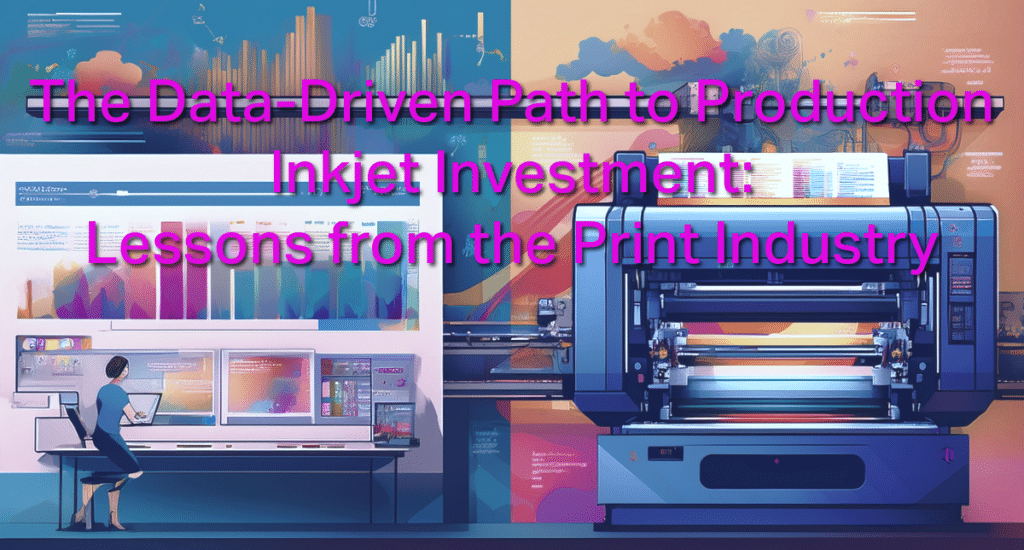Investing in new production hardware—particularly high-value assets like inkjet printers—in our competitive print landscape requires more than a gut feeling or reaction to market trends. Industry leaders across commercial printing, book production, and digital print increasingly rely on comprehensive production data to guide these critical investment decisions.
The Traditional Hardware Investment Dilemma
Historically, print operations have faced significant challenges when evaluating new equipment purchases:
- Reliance on vendor promises rather than objective performance metrics
- Difficulty quantifying current equipment utilization and bottlenecks
- Unclear understanding of true production costs and capacity constraints
- Inability to accurately project ROI for new investments
- Limited visibility into how new equipment will integrate with existing workflows
As Ken Chaletzky of Copy General noted, many operations were making decisions based on “anecdotal production data” rather than “real numbers in a format that was easy to interpret and use.”
The Data-Driven Revolution in Equipment Investment
Forward-thinking print organizations now leverage production intelligence systems to transform their hardware investment approach. This shift provides several key advantages:
1. Establishing Accurate Performance Baselines
Before considering new equipment, leading print operations establish reliable baselines for their current production environment. As Charles Lewis of Merlin Printing explains, “The system provides us with a simple way to collect and analyze data, as well as to improve print shop operations continuously.”
With systems like SpencerMetrics CONNECT®, operations can:
- Measure actual equipment utilization rates (not just perceived busy time)
- Track Overall Equipment Effectiveness (OEE) across different machine types
- Identify specific production bottlenecks and constraints
- Quantify current operational capacity with precision
2. Identifying True Production Costs
The data reveals that many print operations made equipment decisions without fully understanding their cost structures. Brent Halverson of Hal Leonard notes they “gained an automatic activity-based costing system vs. manual entry and dashboards we could use to make better business decisions.”
This cost clarity includes:
- Accurate job costing across different equipment types
- Make-ready time and waste quantification
- Labor productivity metrics by equipment type
- Maintenance and downtime costs
3. Capacity Planning Based on Facts, Not Feelings
With seasonal peaks and varying job characteristics, print operations need to understand their true capacity constraints. Joe Davis of 4over reports they “can now make informed, proactive decisions about shop floor productivity and better understand equipment utilization and capacity planning.”
Data-driven capacity planning enables:
- Identifying when equipment has reached true utilization limits
- Understanding which job types are causing bottlenecks
- Determining whether problems stem from equipment limitations or workflow issues
- Making strategic decisions about in-house production versus outsourcing
4. Projecting ROI with Confidence
Accurate ROI projection becomes essential when evaluating production inkjet investments that can run into millions of dollars. The case studies highlight how data-driven operations can predict returns with greater confidence:
- Merlin Printing identified potential for $330,000 in additional annual revenue through equipment optimization
- Copy General projected $315,000 in increased profits without additional resources
- Entourage Yearbooks achieved ROI within the first production season
As Elias Jo of Entourage Yearbooks noted, “During our yearbook season, we’ve already seen a good return on our investment.”
The Decision-Making Framework for Production Inkjet Investment
Based on the collective experiences of these print industry leaders, a clear framework emerges for making hardware investment decisions:
Phase 1: Production Intelligence Implementation
- Install comprehensive data collection and analytics systems
- Establish baseline metrics across all production equipment
- Create visibility into job costs, equipment utilization, and capacity constraints
- Train staff to leverage data for continuous improvement
Phase 2: Current Environment Optimization
- Use data to maximize existing equipment performance
- Identify and eliminate process inefficiencies
- Improve operator training based on performance metrics
- Implement proactive maintenance schedules to reduce downtime
Phase 3: Gap Analysis and Needs Assessment
- Analyze production data to identify persistent capacity gaps
- Determine where equipment limitations impact customer service levels
- Quantify the business impact of current constraints
- Project growth requirements based on market and customer demands
Phase 4: Investment Analysis and Selection
- Evaluate new equipment options based on objective performance metrics
- Model how different options address identified capacity gaps
- Calculate detailed ROI projections grounded in actual production data
- Consider integration requirements with existing workflow systems
Phase 5: Implementation and Performance Verification
- Monitor implementation with real-time data collection
- Verify performance against vendor promises and projections
- Make rapid adjustments to maximize new equipment’s effectiveness
- Calculate actual versus projected returns on investment
The Competitive Advantage of Data-Driven Investment
Organizations that embrace this data-driven approach gain significant competitive advantages:
- Financial discipline: Investments are tied to verifiable returns rather than speculative benefits
- Faster optimization: New equipment is integrated and optimized more quickly
- Improved equipment selection: Decisions match actual production needs, not perceived limitations
- Enhanced negotiating position: Detailed knowledge of current operations improves vendor discussions
- Continuous improvement culture: Data-based decisions become standard across the organization
The Imperative for Modern Print Operations: Data Before Hardware
As Peter Shima of Lakeside Book Company summarizes, “Our operation has improved as a result of the real-time data visibility and the summary reporting capabilities. Our operators have embraced the feedback and made conscious changes that have positively impacted our results.”
This transformation represents the new standard for production inkjet and other hardware investments. Print organizations that continue to make major capital expenditures without robust production intelligence risk falling behind competitors who leverage data to ensure every dollar invested delivers maximum return.
The message from industry leaders is clear: before considering your next production inkjet investment, establish the data infrastructure to make that decision with confidence and precision.
Find us at Inkjet Summit 2025 and ask the team how our tools can support you.
Not there? Drop us a line, and we’ll get back to you!

